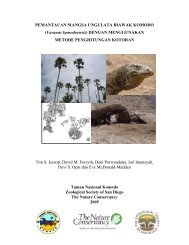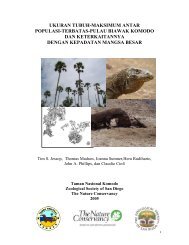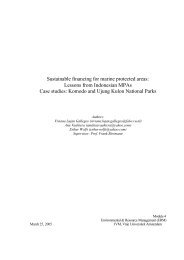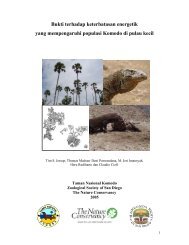Sebaran dan karakteristik pohon sarang Kakatua - Komodo National ...
Sebaran dan karakteristik pohon sarang Kakatua - Komodo National ...
Sebaran dan karakteristik pohon sarang Kakatua - Komodo National ...
Create successful ePaper yourself
Turn your PDF publications into a flip-book with our unique Google optimized e-Paper software.
EXECUTIVE SUMMARY<br />
The Sulphur-crested Cockatoo Cacatua sulphurea is distributed<br />
widely throughout the Wallace bioregion as well as Nusa<br />
Penida and Masakambing, and is one of the Indonesian parrots<br />
threatened by trade and habitat degradation. This bird is<br />
currently classified as a Critically En<strong>dan</strong>gered species and is<br />
protected by Indonesian laws as well. There are four<br />
subspecies of Sulphur-crested Cockatoo; Cacatua sulphurea<br />
sulphurea, C.s. citrinocristata, C. s. abotti and C. s. parvula<br />
which are widespread in Lesser Sunda in Nusa Tenggara<br />
except for the island of Sumba. All sub species are threatened<br />
with extinction following the decline of their populations due to<br />
over-capture and trade of hundreds of thousands of individual<br />
birds in the last decades.<br />
This study focused on the distribution and characteristics of the<br />
Sulphur-crested Cockatoo nesting tree on the <strong>Komodo</strong> Island,<br />
<strong>Komodo</strong> <strong>National</strong> Park, and was conducted during March and<br />
April 2005. This study was a collaborative project between the<br />
Center for Conservation and Research of En<strong>dan</strong>gered Species<br />
<strong>Komodo</strong> Project, <strong>Komodo</strong> <strong>National</strong> Park, Kokokan, and<br />
Udayana University<br />
<strong>Komodo</strong> <strong>National</strong> Park is 1.817 km 2 in size and is located<br />
between Sumbawa and Flores Island. It is a World heritage<br />
Site, and includes the islands of <strong>Komodo</strong> (316 km 2 ), Rinca (205<br />
km 2 ) and numerous other small islands. <strong>Komodo</strong> Island is<br />
mostly covered by savanna (approx 59%), monsoon forest<br />
(approx 38%), and mountainous quasi-cloud forest (approx 3%)<br />
(Imansyah, 2005, unpublished data). Along coastal areas,<br />
mangrove forest covers various locations, particularly along<br />
Eastern and Northern Island.<br />
Long term nest monitoring is expected will provide particular<br />
information on the breeding status and the annual trends of the<br />
Cockatoo population. On <strong>Komodo</strong> Island, 30 potential nesting<br />
trees have been found, whereas 18 were active. Loh Liang had<br />
the most active nests (11), other valleys had fewer - 7 and 1<br />
active nests in Loh Sebita and Loh Wau respectively.<br />
5






